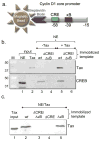The HTLV-1 tax protein cooperates with phosphorylated CREB, TORC2 and p300 to activate CRE-dependent cyclin D1 transcription
- PMID: 20101207
- PMCID: PMC2851846
- DOI: 10.1038/onc.2009.498
The HTLV-1 tax protein cooperates with phosphorylated CREB, TORC2 and p300 to activate CRE-dependent cyclin D1 transcription
Abstract
Adult T-cell leukemia/lymphoma is a fatal malignancy etiologically linked to infection with the human T-cell leukemia virus (HTLV-1). The virally encoded oncoprotein Tax activates the transcription of HTLV-1 and cellular genes by cooperating with cellular transcription factors. Cyclin D1 is a pivotal regulator of cell cycle progression, and increased expression strongly correlates with malignant transformation. Here, we characterize the mechanism of Tax transactivation of cyclin D1. We find that cyclin D1 transcript levels are elevated in HTLV-1 infected cells and that Tax physically associates with the cyclin D1 gene in vivo. Tax binds the cyclin D1 promoter-proximal cyclic AMP response element (CRE) in the presence of phosphorylated CREB (pCREB) in vitro, and together the Tax-pCREB complex recruits the cellular co-activator p300 to the promoter through this unconventional Tax-responsive element. We further show that the transducer of regulated CREB 2 (TORC2) cooperates with Tax to further enhance p300 recruitment to the cyclin D1 promoter in vitro. Tax and TORC2 in combination stimulate cyclin D1 expression in vivo, demonstrating the functional outcome of the binding interactions. Together, our findings support a model in which Tax-induced accumulation of cyclin D1 shortens the G1 phase of the cell cycle, promotes mitotic replication of the virus, and drives selection and expansion of malignant T-cells.
Conflict of interest statement
The authors declare no conflict of interest.
Figures







Similar articles
-
Molecular characterization of the Tax-containing HTLV-1 enhancer complex reveals a prominent role for CREB phosphorylation in Tax transactivation.J Biol Chem. 2007 Jun 29;282(26):18750-7. doi: 10.1074/jbc.M700391200. Epub 2007 Apr 20. J Biol Chem. 2007. PMID: 17449469
-
The human T-cell leukemia virus type 1 tax protein confers CBP/p300 recruitment and transcriptional activation properties to phosphorylated CREB.Mol Cell Biol. 2008 Feb;28(4):1383-92. doi: 10.1128/MCB.01657-07. Epub 2007 Dec 10. Mol Cell Biol. 2008. PMID: 18070920 Free PMC article.
-
Tax abolishes histone H1 repression of p300 acetyltransferase activity at the human T-cell leukemia virus type 1 promoter.J Virol. 2006 Nov;80(21):10542-53. doi: 10.1128/JVI.00631-06. Epub 2006 Aug 30. J Virol. 2006. PMID: 16943293 Free PMC article.
-
[Adult T-cell leukemia induced by HTLV-1: before and after HBZ].Med Sci (Paris). 2010 Apr;26(4):391-6. doi: 10.1051/medsci/2010264391. Med Sci (Paris). 2010. PMID: 20412744 Review. French.
-
Anti-apoptotic effect of Tax: an NF-κB path or a CREB way?Viruses. 2011 Jul;3(7):1001-14. doi: 10.3390/v3071001. Epub 2011 Jun 27. Viruses. 2011. PMID: 21994767 Free PMC article. Review.
Cited by
-
Modes of Human T Cell Leukemia Virus Type 1 Transmission, Replication and Persistence.Viruses. 2015 Jul 7;7(7):3603-24. doi: 10.3390/v7072793. Viruses. 2015. PMID: 26198240 Free PMC article. Review.
-
Hijacking of the O-GlcNAcZYME complex by the HTLV-1 Tax oncoprotein facilitates viral transcription.PLoS Pathog. 2017 Jul 24;13(7):e1006518. doi: 10.1371/journal.ppat.1006518. eCollection 2017 Jul. PLoS Pathog. 2017. PMID: 28742148 Free PMC article.
-
GPR137 Inhibits Cell Proliferation and Promotes Neuronal Differentiation in the Neuro2a Cells.Neurochem Res. 2023 Mar;48(3):996-1008. doi: 10.1007/s11064-022-03833-4. Epub 2022 Nov 27. Neurochem Res. 2023. PMID: 36436172 Free PMC article.
-
Infection, mutation, and cancer evolution.J Mol Med (Berl). 2012 May;90(5):535-41. doi: 10.1007/s00109-012-0891-2. Epub 2012 Apr 4. J Mol Med (Berl). 2012. PMID: 22476248 Review.
-
Highlights on distinctive structural and functional properties of HTLV Tax proteins.Front Microbiol. 2013 Sep 9;4:271. doi: 10.3389/fmicb.2013.00271. Front Microbiol. 2013. PMID: 24058363 Free PMC article. Review.
References
-
- Albanese C, Johnson J, Watanabe G, Eklund N, Vu D, Arnold A, et al. Transforming p21ras mutants and c-Ets-2 activate the cyclin D1 promoter through distinguishable regions. J Biol Chem. 1995;270:23589–97. - PubMed
-
- Bittinger MA, McWhinnie E, Meltzer J, Iourgenko V, Latario B, Liu X, et al. Activation of cAMP response element-mediated gene expression by regulated nuclear transport of TORC proteins. Curr Biol. 2004;14:2156–61. - PubMed
-
- Conkright MD, Canettieri G, Screaton R, Guzman E, Miraglia L, Hogenesch JB, et al. TORCs: transducers of regulated CREB activity. Mol Cell. 2003;12:413–23. - PubMed
Publication types
MeSH terms
Substances
Grants and funding
LinkOut - more resources
Full Text Sources
Research Materials
Miscellaneous

